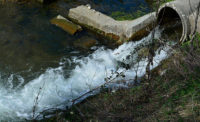Tech | Processing
Repurposing wastewater
Innovative, sustainable cleaning systems shrink treatment systems.

Managers at aging processing plants are poised to improve or replace their existing wastewater systems. What will they find? Innovative, sustainable and less expensive cleaning systems that now require smaller footprints.
“The decision to use new advanced wastewater treatment technologies by poultry processing plants is based on two major factors,” says Brian H. Kiepper, Ph.D., associate professor and extension specialist in the Department of Poultry Science at the University of Georgia, based in Athens. “The first is ensuring that the treatment system in place can consistently meet ever more stringent environmental permit regulations limits. The second is to increase the potential for water reuse in both non-food- and food-contact applications.”
Poultry facilities generally clean wastewater through physical separation, such as screens and dissolved air flotation (DAF), chemicals to enhance DAFs and biological treatment (aeration, anaerobic) depending on their discharge permits. “Tertiary treatment including chlorination/dechlorination or UV light completes the process in some locations,” says John Pierson, principal research engineer at Atlanta-based Georgia Tech Research Institute.
In the upper Midwest, a poultry processing plant is using an integrated membrane bioreactor (MBR) or membrane cassettes (sometimes referred to as spaghetti strings) suspended directly in the reactor to produce a highly treated effluent stream that can directly discharge into an environmentally sensitive stream nearby, Kiepper says.
“There is currently a poultry processing plant in north Georgia that utilizes a recirculating MBR in combination with UV-C disinfection on well over 1 million gallons per day of wastewater,” says Kiepper. “They are currently exploring the possible uses of this highly treated wastewater stream back in the plant, specifically in food-contact applications.”
In the past, the cost of membrane bioreactors for wastewater treatment was a barrier for implementation. “But recently, more companies have started using membrane bioreactors — or at least, thinking of implementing them — because costs are down and permits are becoming stricter,” says Paul Bredwell, executive vice president of regulatory programs at the U.S. Poultry and Egg Association, in Tucker, Ga.
As plants age, they can replace older wastewater systems with improved technology that requires smaller footprints, Bredwell says. “They have a unique opportunity to treat wastewater to a higher level. With MBR, the membranes can remove bacteria, while high-level filters eliminate viruses and personal care products that build up over time,” he says.
The treatment systems’ footprints are smaller because they can run a higher concentration of bacteria through stronger levels of treatment in smaller areas.
Georgia Tech Research Institute, for example, continues to experiment with a Dynamic Filtration System that stops particles before the filter and removes them in a smaller footprint.
“While the system can treat wastewater, we have focused its development on specific unit processes inside of facilities to reduce the overall load to wastewater,” Pierson says. “That helps facilities that do not have flow equalization. For facilities with flow equalization, slug loads can be eliminated.”

Focusing on individual unit processes within the facility allows processors to tailor the technology to their needs, notes Pierson. “Treating liquid streams that contain product or have just washed product (before discharge) increases finer byproduct recovery — small pieces of meat and fat,” he says. “Water reuse or recycle is also improved.”
For the beef and pork industries, many of their plants are located in communities where there is not a shortage of space. Those plants are able to use covered anaerobic wastewater lagoons for methane recovery, for example, as part of their process train.
“As these plants get larger, they are using large scale treatment systems,” says Bruce Dvorak, Ph.D., professor, University of Nebraska-Lincoln. “Some plants pretreat their wastewater before discharging to a municipal wastewater plant, which commingles the wastewater with municipal sewage for final treatment.”
Many food and meat processing plants will pretreat the water they bring in (municipal drinking water or groundwater) to a higher standard to use in the hot-water systems and boiler systems. “It is not uncommon for treatment systems including RO and/or ion exchange to be used for pre-treatment of specific potable water streams or process water streams,” Dvorak says.
For meatpackers, a pretreatment technology that is low cost and low maintenance to remove solids and oils and grease is critical. “A second opportunity that exists with many meat processors is the development of low-cost anaerobic digestion approaches to allow for on-site methane production,” says Dvorak. “As on-site anaerobic digestion becomes most cost effective and low maintenance, facilities will move away from outsourcing the treatment of high-strength wastes to their local municipal wastewater treatment plants.”
As water scarcity increases in the West and Plains states, food processors and meatpackers will continue to invest in water reuse and water conservation technologies, Dvorak says.
Poultry processors have been reusing water in non-food-contact areas of the plants for decades. “As an example, water is used in flumes to move feathers off the production floor to offal collections areas,” Kiepper says. “This wastewater stream is screened and then the resulting ‘targeted treatment’ wastewater is recirculated back up to the feather-picking area and recharges the feather flume.”
More recently it has become common for plants to used targeted treatment to capture and collect relatively “clean” process water, such as the carcass rinse, from the end of the processing line and send it back up the processing line to be used in various “dirtier” applications such as scalder make-up water.

“Many plants employ multiple internal loops like these,” Kiepper says. “There are even plants now that have large collection systems that collect ‘clean’ water from various points, send that relatively clean wastewater stream through a dedicated screening and filtration system — some into the ultrafiltration range — and then distribute that targeted treated wastewater to multiple areas back at the beginning of the processing line.”
In addition, plants are putting in place instrumentation that will shut off water if product is not running through it or employ people who make sure water is not being wasted, notes Bredwell. NP
Looking for a reprint of this article?
From high-res PDFs to custom plaques, order your copy today!








